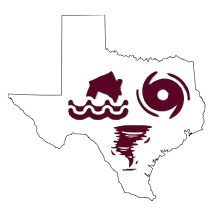State & Federal Assistance Programs
Your first avenue for financial assistance after a disaster is to work with your insurance agent and file a claim. Whether you have insurance or not, it is also possible to receive assistance from several state and federal programs. Eligibility is always determined on a case-by-case basis, especially if you do receive money from an insurance claim. Programs are not only available for home repair; they can include new construction, relocation, and rental units. In Texas, some federal programs are administered by state-run agencies. This will be explained more in the following sections. The availability of each program also depends on whether the disaster is a local declaration, state declaration, or presidential declaration.
Local Disaster Declaration is handled by the local emergency management plan. If the local community (e.g., city or county) does not have the capacity to handle the circumstances, it can appeal to the state.
State Disaster Declaration is decided by the Governor, even if the disaster does not affect the whole state. Texas has its own agencies that can offer assistance to communities affected by state declared disasters.
Texas Department of Housing and Community Affairs (TDHCA) can apply funds that it regularly receives from federal housing programs to assist in disaster recovery. The most common program is the HOME Investment Partnerships Program (HOME). HOME provides states and localities with grant money for various activities including building, buying, and/or rehabilitating affordable housing for rent or homeownership, and for providing direct rental assistance, especially for low-income households.
Presidential Disaster Declaration may be granted only when the Governor requests federal assistance, either during or after the disaster event. With a presidential declaration, many more opportunities are available for communities to pass down financial assistance to homeowners and renters.
FEMA Individual Assistance (IA) is administered directly to homeowners and renters and is not dependent on community participation in any program. It is typically the second avenue of financial assistance after an insurance policy. It pays for a variety of services in addition to housing.
FEMA Public Assistance (PA) helps communities to get back up and running again by paying for debris removal and infrastructure repairs in neighborhoods.
Hazard Mitigation Grant Program (HMGP) is funded by FEMA but is administered by the Texas Division of Emergency Management (TDEM). Hazard Mitigation in theory is implemented before a disaster, in order to reduce the risk from hazards. However, communities can receive recovery funding if their state has or agrees to develop a state-wide Hazard Mitigation Plan. Whether projects are implemented before or after a disaster, they are intended to benefit the whole community. Projects can be structural (e.g., levees and floodwalls) or non-structural (e.g., protecting wetlands and land use planning). Sometimes these projects benefit individuals as well, especially when local government can buy properties located in the floodplain and assist homeowners in relocating to nonhazardous areas. More information is available in this fact sheet provided by the Texas Department of Public Safety.
Flood Mitigation Assistance (FMA) is administered by the Texas Water Development Board (TWDB) but is only available to communities that participate in the NFIP. The supported projects are similar to HMGP projects, such as relocation, building elevation, and flood control.
Flood Protection Planning is also administrated by TWDB and is focused on early warning systems and other response efforts in NFIP-participating communities.
Community Development Block Grant – Disaster Recovery (CDBG-DR) is administered by the Texas General Land Office (GLO), but the funding comes from the U.S. Department of Housing and Urban Development (HUD). GLO must create a state-wide action plan explaining how it will use the funding, and HUD must approve the plan, before the funds are released. The action plan is posted for public comment for a limited time, so Texas residents can advocate for different projects if they disagree with the plan. Like many other programs, CDBG-DR is only available at a community level, but it is also specifically for low-income and other socially vulnerable neighborhoods. The projects are aimed at elimination of blight and slums, and supporting fair and affordable housing, infrastructure upgrades, and economic development. Individuals could benefit from the projects in a multitude of ways, so reading and understanding the action plan is advised. More information is available in this fact sheet provided by HUD and this fact sheet provided by GLO.
Texas Rebuilds was developed by GLO as a disaster recovery program that uses funding from various organizations, including HUD. The program provides assistance to renters, current homeowners, and people interested in becoming first-time homeowners. Several options are available to people who live in designated areas and meet other requirements. Typically, assistance is given to people wishing to rebuild or to relocate. The Homeowner Opportunity Program (HOP) allows homeowners to participate in a voluntary relocation process. Relocation in this program does not refer to moving one’s house, but rather to moving someone to a safer neighborhood. Individuals who choose to participate must transfer ownership of their property, usually to the local government. Structures on the property are then demolished and the land is no longer developed. In return, the homeowner receives assistance in purchasing an existing home or in purchasing a vacant lot for building a new home. Financial assistance is provided, as well as consultations for decision-making and real estate transactions.
Small Business Association (SBA) loans are available to individuals after they have already pursued insurance claims and FEMA’s Individual Assistance. You do not need to be a business owner to apply for an SBA loan; you can be a homeowner, renter, or member of a common-interest development (e.g., homeowner associations or condominiums). Loans can pay for repairs, personal property, relocation assistance, and sometimes mortgage refinancing.
